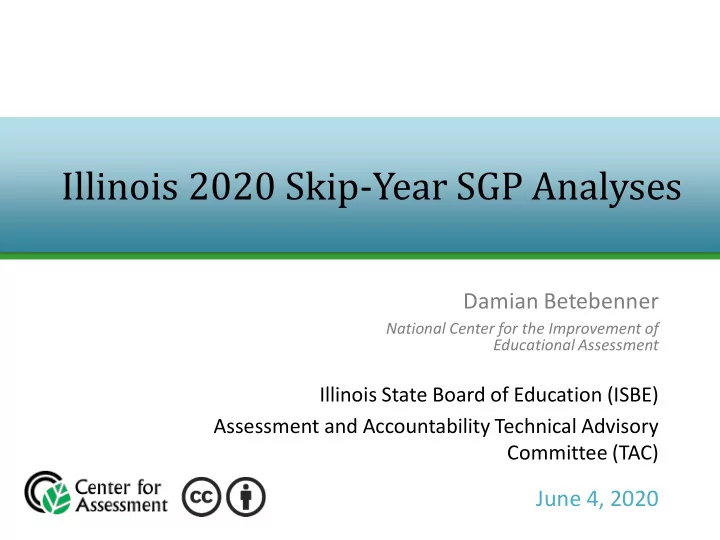

Illinois 2020 Skip-Year SGP Analyses Damian Betebenner National Center for the Improvement of Educational Assessment Illinois State Board of Education (ISBE) Assessment and Accountability Technical Advisory Committee (TAC) June 4, 2020
COVID-19 Pandemic • Oh what a difference a couple of months make. • Most Spring 2020 tests have been cancelled: – State assessments in ELA/Math have been cancelled – Many ELP assessments (WIDA/ACCESS) were completed, at least by most students in the state • States, including Illinois, have been given assessment and accountability waivers by ED for 2020. • Because student academic growth as measured by state summative assessments utilizes prior assessment data in its calculation, the impacts of the 2020 pandemic will have ripple effects in 2021. • My colleague Adam VanIwaarden and I wrote a blog post on this topic in April which can be found here: https://www.nciea.org/blog/sgp/issues- and-considerations-covid-19-pandemic-presents-measuring-student- growth [Presentation Title - Footer] 2
2021 SGP Calculation • I have discussed whether growth can be calculated in 2021 and whether it can be used for accountability (e.g., school or teacher) with more than two-dozen states. • Simple answer: Yes, SGPs can be calculated using 2019 (and earlier data) as priors. – Several states have been calculating two-year growth for years when there is not annual sequence of tests. For example, 8 th to 10 th grade growth in ELA or Mathematics or End of Course testing. – Growth projections which yield Adequate Growth Percentiles (AGPs) will also be calculable in 2021. • The harder question is whether these SGPs can/should be used as part of state accountability. – Are two-year SGPs valid as indicators of annual growth? – Beyond technical viability, is it tenable (e.g., politically) to use two-year SGPs as a substitute for one-year SGPs? [Presentation Title - Footer] 3
2021 SGP Calculation • Are two-year SGPs valid as indicators of annual growth? – The paper on which this presentation is based shares some findings and will be discussed hereafter. • Is it tenable (e.g., politically) to use two-year SGPs as a substitute for one-year SGPs? – A much harder question that likely differs from state to state. – Answering it well requires technical due diligence which, hopefully, this report/presentation begins to address. [Presentation Title - Footer] 4
Illinois SGP Calculation • Illinois, as a member of the PARCC consortium has had SGPs calculated since Spring of 2016. • Illinois assesses students in ELA and Mathematics in grade 3, 4, 5, 6, 7 and 8. • As mentioned previously, there is no summative data in 2020 due to the COVID-19. • To investigate the use of two-year SGPs in lieu of one-year SGPs, we used historical data as follows [Presentation Title - Footer] 5
Illinois SGP Calculation • Using historical data from 2016 to 2019, two-year SGPs from 2017 to 2019 were calculated using 2019 as the dependent variable and 2016 and 2017 as the independent variables (i.e., order 1 and 2 SGPs) – Two-year SGPs are calculated for grades 5, 6, 7, 8 in ELA and Mathematics. – SGPs are calculated separately for each norm-group. • One-year SGPs from 2018-2019 were available from previous SGP analyses. – One-year SGPs are calculated for grades 4, 5, 6, 7, and 8. – SGPs are calculated separately for each norm-group. [Presentation Title - Footer] 6
Illinois SGP Results • Frequencies associated with SGPs. • In general, there are between 135,000 and 140,000 students with SGPs in each grade and content area. • Note when more priors are used, the count decreases slightly due to some students not having the additional prior. [Presentation Title - Footer] 7
Illinois SGP Results: Individual • Correlations between two-year SGPs and one-year SGPs (of order 2) were all high. – Correlations ranged from 0.85 to 0.9 across grades and content areas. – When one-year/order 1 SGPs are considered, correlations drop to 0.65 to 0.7. This is likely due to the fact that the 2017 score is not a part of both one- and two-year analyses. • Differences between individual SGPs can be large. [Presentation Title - Footer] 8
Illinois SGP Results: School Level • School level data was not provided as part of Pearson data sets. We substituted another states data for this part until IL school data becomes available. • Correlations between two-year mean SGPs and one-year mean SGPs (of order 2) were all high, higher than at the individual level. – Correlations ranged from 0.9 to 0.95 across grades and content areas. • Differences between two- and one-year mean SGPs can be large. [Presentation Title - Footer] 9
Illinois SGP Results: School Level • For context, the year-to-year correlations between mean school SGPs is approximately 0.5 to 0.6. • Model-to-model (i.e., one-year to two-year) SGP correlations are much higher than year-to-year correlations implying that changing student populations • Correlations of 0.9 are common in comparisons between SGP and VAM. • SGP differences of 5 correspond to an effect size of 0.18. – The majority of mean SGP difference correspond to small effect sizes. [Presentation Title - Footer] 10
Summary • Two-year growth (2019 to 2021) is not difficult to calculate and has been done in many states over the last decade. • In examining differences between two-year (2017- 2019) growth and one-year (2018-2019) growth: – At the individual level, correlations are high, but some individual differences are large. It is probably not realistic to substitute two-year growth as a measure of individual one-year growth. – At the school level, correlations are high and school mean differences are modest. It is likely technically defensible to substitute two-year growth as a measure of school one-year mean growth. • Whether it is practically tenable is another question. [Presentation Title - Footer] 11
For more information: Center for Assessment www.nciea.org
Recommend
More recommend